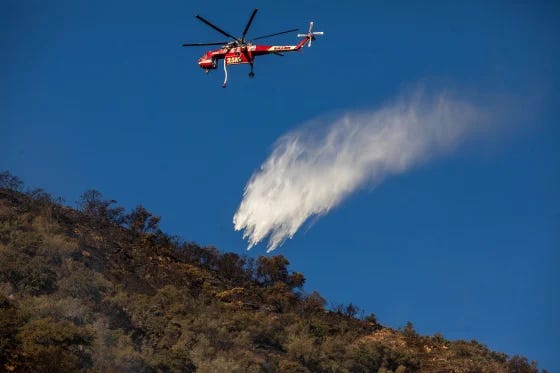Hughes Fire Containment Increases as Thousands Return Home
While the wildfire north of Los Angeles has scorched more than 10,000 acres, no structures have been lost, and evacuation orders are being lifted as containment efforts progress.
LOS ANGELES — Firefighters made significant progress Thursday in containing the Hughes Fire, a fast-moving brush fire that erupted north of Los Angeles on Wednesday and rapidly spread due to strong winds.
The wildfire, which ignited near Castaic Lake, had grown to over 10,000 acres by Thursday evening but was reported to be 36% contained, according to the California Department of Forestry and Fire Protection (Cal Fire).
Despite the fire's rapid expansion, no buildings have been destroyed, officials confirmed.
Initially, more than 31,000 people were placed under mandatory evacuation orders. By Thursday afternoon, those orders had been lifted, though approximately 54,900 residents remained under evacuation warnings, meaning they should be ready to leave if conditions worsen, according to the Los Angeles County Sheriff’s Department.
“This was one of those aggressive, wind-driven fires that can be incredibly difficult to control,” said Brent Pascua, a battalion chief with Cal Fire, on Thursday.
The blaze erupted amid critical fire weather conditions, driven by the region’s notorious Santa Ana winds. The incident follows closely on the heels of the devastating Palisades and Eaton fires, which ignited earlier this month, killing at least 28 people and destroying thousands of homes.
The Hughes Fire was first reported around 10:24 a.m. Wednesday near Lake Hughes Road in northern Los Angeles County. The combination of dry vegetation and high winds provided ample fuel for its rapid spread, Pascua explained. Authorities are still investigating the cause of the fire.
Meanwhile, a second blaze broke out Wednesday in Sepulveda Pass near the densely populated Sherman Oaks neighborhood and UCLA. That fire grew to 40 acres before firefighters managed to halt its progress. By Thursday, it was 60% contained, Cal Fire reported.
The National Weather Service issued a "red flag" warning for the region, which remains in effect until 10 a.m. Friday. While the most extreme fire weather was expected Thursday, officials cautioned that any new fire could spread rapidly under current conditions.
Although the Hughes Fire spread quickly, Los Angeles County Fire Chief Anthony Marrone noted that its winds were not as extreme as the hurricane-force gusts that fueled the Palisades and Eaton fires on January 7, which left firefighting aircraft grounded due to dangerous conditions.
Experts continue to warn about the role of climate change in creating the conditions that fuel these devastating wildfires, which have ravaged Southern California in recent weeks.
The Palisades and Eaton fires caused widespread destruction, with officials labeling them among the worst disasters in Los Angeles history.
The Eaton Fire, which tore through Altadena and surrounding communities, was reported to be 95% contained by Thursday after scorching over 14,000 acres. More than 9,400 structures, including homes, were destroyed.
Meanwhile, the Palisades Fire severely impacted Pacific Palisades, Malibu, and areas along the scenic Pacific Coast Highway. It has burned over 23,400 acres and was 72% contained as of Thursday, according to Cal Fire.
Both fires were fueled by extreme Santa Ana winds that reached hurricane-force speeds of over 80 mph, creating what officials described as a firestorm.
Investigations into the causes of the Hughes, Palisades, and Eaton fires remain ongoing.


